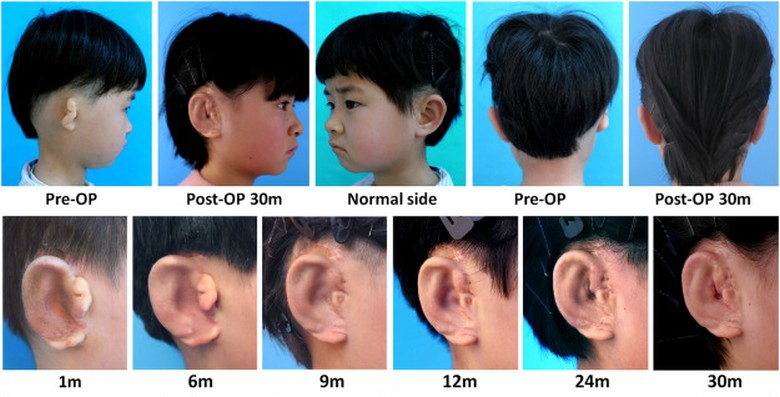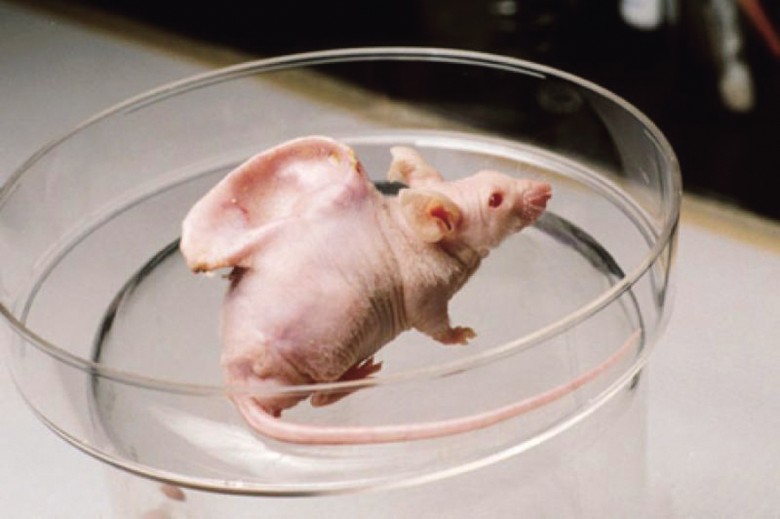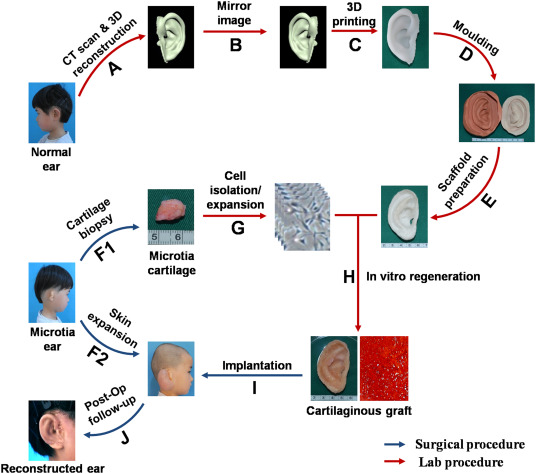Chinese doctors raised new ears for children

Ear growth after implantation. Before the operation, the microtic site has the shape of a peanut. Two and a half years after implantation, typical features of the auricle, almost symmetrical to the healthy ear, appeared.
For the first time in the world, scientists managed to grow full-fledged auricles from the patient's own cells. Five Chinese children received one ear each.
Microtia is a congenital malformation of the auricle when it is not sufficiently developed or deformed. Unfortunately, this defect is not so rare: in different regions of the world, the frequency varies from 0.83 to 17.4 per 10,000 newborns. Even if a child has normal hearing, the restoration of the auricle makes sense because it is an important identification feature of the human face, say the authors of the new scientific work from the Shanghai School of Medicine Jiao Tong and the Plastic Surgery Hospital of the Chinese Academy of Medical Sciences. In addition, these children can not wear glasses, often suffer from low self-esteem and psychological disorders.
In this case, the Chinese experts used a technique similar to that used in the operation of the famous laboratory mouse Vakanti , who had a human ear on her back in the 90s.
')

Vacanti Mouse
The operation was specifically performed on a nude mouse (Nude), a breed of laboratory mice with a genetic mutation, manifested in underdevelopment or absence of the thymus, which leads to suppression of immune functions. The operation was conducted by a group of physicians from the University of Massachusetts School of Medicine under the leadership of Charles Vacanti, also known under the nickname Chuck. The results were published in 1997. At one time, this scientific experiment caused serious unrest among activists for the protection of animal rights and religious groups.
Since then, the experiment has been repeatedly reproduced on various animals, but the Chinese colleagues were the first to decide to experiment on humans.
The technique is fairly simple (see schematic illustration below). A child 3D-scanned healthy ear, then a mirror transformation is performed on the computer, and then a form is printed on the 3D-printer. Auricles are formed from a biodegradable material, then populated by the patient's cartilage cells. At the same time, a so-called “tissue expander” is implanted on the microtic site, which frees up space for the future implant from cartilage cells. By the time when the latter multiply and fill the form, a sash is formed on the skin at the microtic site, where the blank is placed.

Schematic illustration of the reconstruction of the auricle from cartilage cells
“This is a very exciting approach,” says Dr. Tessa Hadlock from Massachusetts Eye and Ear Infirmary. This research institution specializes in research on how to treat the eyes, ears, nasopharynx, head and neck. “They showed that it is possible to come closer to restoring the structure of the auricle.”
Standard techniques for treating microtia involve the implantation of a synthetic ear or cartilage in the shape of an ear taken from the ribs of a child. But both methods have their drawbacks: in the first case, the auricle does not perform its function as an organ of hearing, and in the second case, surgery on the patient's ribs is required. Doctors believe that the new method is simpler and more effective than the existing ones. In addition, it also provides the best appearance of the ears. However, it remains unknown how long the complete restoration of the structure of the auricle and what it will take final form will take. Specialists will monitor each of the five patients for five years.
At the moment, the first of five patients who were operated on 2.5 years ago showed a very good result. The remaining four were implanted with cartilage cells later, and the results are also quite good, although some of them have deformed ears.
A scientific article with the results of clinical trials was published on January 12, 2018 in the journal EBioMedicine (10.1016 / j.ebiom.2018.01.011).
Source: https://habr.com/ru/post/374215/
All Articles